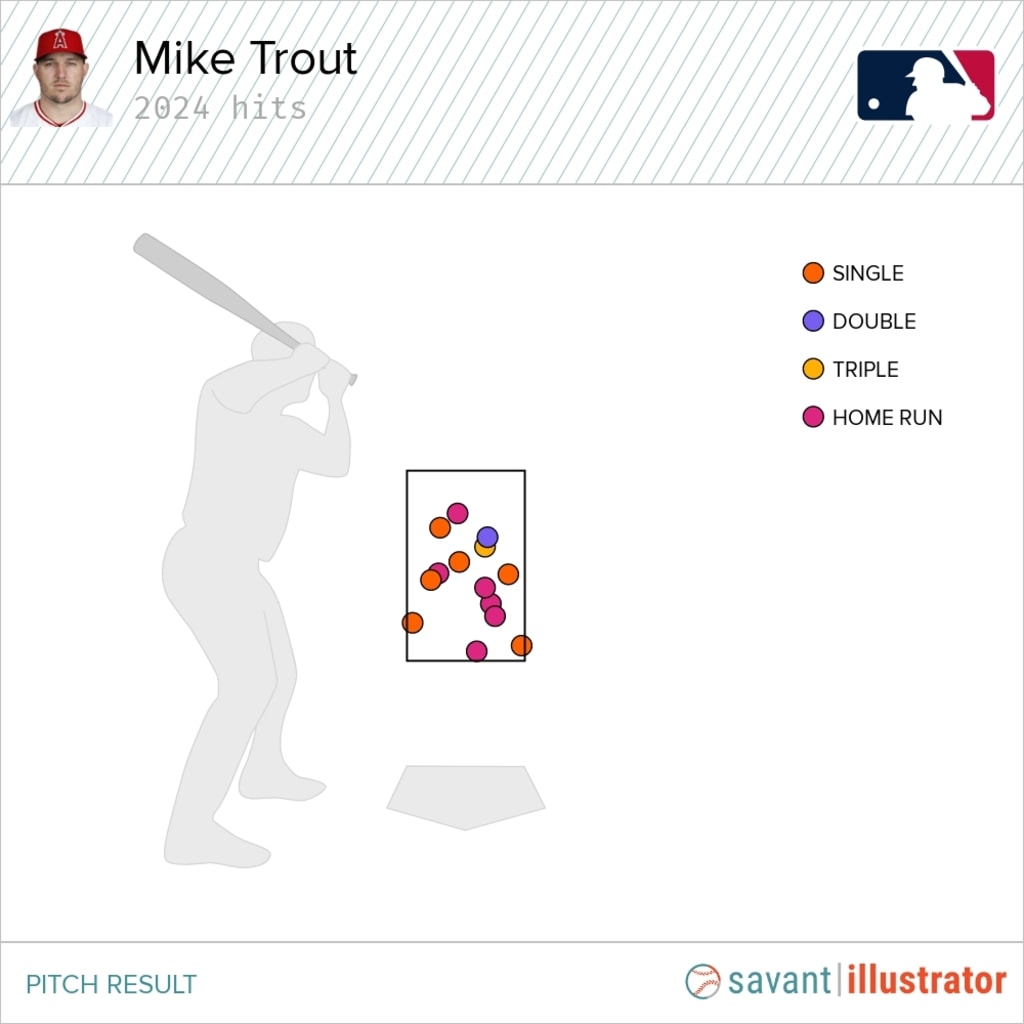Few players in MLB history have compiled a peak like Mike Trout had in the 2010s.
From 2012-19 (1,159 games), Trout slashed .308/.422/.587 with a 178 OPS+ that was far and away the best among hitters with at least 1,000 plate appearances (David Ortiz was next-closest at 154), while Trout's 70.5 Wins Above Replacement (FanGraphs) were more than 20 wins better than the next-best player ( Max Scherzer at 48.5).
Unfortunately, Trout's career has slowed down in the last half-decade largely due to injuries -- he's played in 100 games in a season just once in the three seasons since the shortened 2020 campaign. While Trout maintained his usual excellence during most of that stretch, we saw signs of decline in '23 when Trout's 132 OPS+ was the lowest since he debuted as a 19-year-old rookie in 2011.
Could a second act of Trout excellence be on the table? He is off to a scorching-hot start with a .306/.382/.735 line and 0.9 fWAR while he became the quickest Angels player to hit six home runs (11 games) in a season. Here are five signs the 32-year-old Trout has turned back the clock and is playing like he did in his peak years.
1. Career-best contact numbers
Even at his peak, Trout struck out a decent amount and it was a non-issue because he'd slug and get on base more than everybody. That said, his contact issues became much more pronounced in recent years.
Whereas Trout only whiffed on 20.2 percent of swings in his 2012-19 prime, that figure jumped to 29.2 percent from 2021-23. All three latter seasons were the highest whiff seasons in his career.
Trout has fixed that issue in 2024 and then some.
Trout from 2021-23 vs. 2024
Whiff rate: 29.2% / 14.4%
Strikeout rate: 24.9% / 18.2%
Zone contact rate: 76.3% / 87.2%
Chase contact rate: 52.7% / 78.9%
It's only a 13-game sample but Trout's improvements have been staggering. Trout's whiff rate would easily be the lowest of any season of his career, while his strikeout rate would rank second behind his 2017 season (17.8%). Among qualified players this season, Trout's 14.9 percentage point decline in whiff rate is bested only by Anthony Volpe.
2. Crushing fastballs and breaking balls again
You can see how Trout has compiled an excellent career by zoning in on his success against the three pitch groups: fastballs, breaking balls and offspeed pitches.
Trout's career numbers vs. pitch groups
Trout vs. fastballs: 1.017 OPS, 17.9% whiff rate
Trout vs. breaking balls: .860 OPS, 30.3% whiff rate
Trout vs. offspeed pitches: 1.074 OPS, 27.4% whiff rate
Trout maintained his usual dominance against offspeed pitches last season (1.192 OPS) but we saw the first real signs of decline against velocity and breaking balls. Trout promptly adjusted and is once again dominating against those two pitch groups.
Trout in 2023 vs. '24
OPS vs. fastballs: .862 / 1.126
Whiff rate vs. fastballs: 26.2% / 13.1%
OPS vs. breaking balls: .742 / 1.077
Whiff rate vs. breaking balls: 40.0% / 8.3%
That last number is eye-popping, even if it's in a smaller sample. Trout didn't have a whiff against a breaking ball until he swung through a pair in Friday's game against the Red Sox.
The improvement against fastballs is stark, too. After crushing 24 homers against fastballs in 2022 (fourth-most in baseball), Trout's .862 OPS against fastballs last season was his worst mark since his '11 debut season.
3. Dominating in and around the zone
It's hardly surprising that Trout -- who blends elite power and plate discipline -- has dominated pitches in and around the zone throughout his career.
Against pitches in the heart of the zone and the shadow zone (pitches near the edge of the zone), Trout owns a career .319/.359/.627 line. Since his first full season in 2012, Trout's 157.3 Run Value added -- assigned value based on its outcome (ball, strike, HR, etc.) -- are the most in the Majors.
We saw his first dip in production against those pitches last season. It was the first time since his debut season that Trout produced a below-average run value against both pitches in the heart of the zone and shadow zone. Like we've seen elsewhere in Trout's profile, we've seen him revert to his old ways.
Trout's numbers vs. heart/shadow pitches
Career: .319/.359/.627 line
2023: .287/.322/.522 line
2024: .333/.388/.800 line
With Trout's improved contact numbers and even more extreme selectivity -- Trout's 16.5 percent chase rate would easily be the lowest in any season (excluding the COVID-shortened 2020 season) and is well below his career 20.9 percent rate -- he's doing plenty of damage on anything close to hittable. Before singling against a pitch out of the zone Friday night, Trout's first 14 hits came on pitches either in the heart or shadow of the zone.

After whiffing on 23.2 percent of pitches in the heart/shadow zone from 2022-23, Trout has nearly halved that with a 13.6 percent rate this season. With more contact in the zone has come more chances for Trout to ...
4. Elevate and celebrate
Trout has managed the impressive combination of putting significantly more balls in play while maintaining his excellent contact quality.
While Trout's average exit velocity (52nd percentile) and hard-hit rate (48th percentile) have dropped, he is barreling baseballs (15.4 percent) right at his career norm (16.4%). That's because Trout is getting far more baseballs in the air, an optimal outcome for any hitter but especially for someone with Trout's raw power.
Trout's career numbers vs. 2024
Groundball%: 32.6% / 20.5%
Fly-ball%: 29.9% / 51.3%
Avg. launch angle (since '15): 19 degrees / 27.8 degrees
All three figures in 2024 would -- you guessed it -- be career marks for Trout. Trout's fly-ball rate leads all qualified hitters this year (no other hitter is above 50 percent) while his ground-ball rate and average launch angle trail only two hitters.
Like most hitters, Trout's numbers are much better when he gets the ball in the air. Trout owns a career 1.679 OPS on fly balls and line drives compared to a .667 OPS on grounders.
5. Speed and defense
Despite playing in the big leagues for 14 years and dealing with various injuries, Trout has remarkably maintained his elite speed and athleticism.
While we don't have Statcast numbers for Trout's initial season -- he stole a combined 82 bases from 2012-13 -- he's consistently ranked in the 90th-plus percentile in sprint speed since 2015. His 28.4 feet-per-second sprint speed so far in '24 would be his lowest mark, yet it still ranks in the 88th percentile.
As such, Trout made it a goal this season to swipe more bags.
"I think 20-plus [stolen bases] would be cool," Trout told MLB.com's Angels beat writer Rhett Bollinger. "Thirty would be really cool."
So far, Trout is making true on that promise and desire to steal more bases. Trout's two stolen bases already match his season high dating back to the 2020 season. In conjunction with MLB's new rules incentivizing stolen bases, Trout's plan to steal 20-plus bags could happen.
Trout's speed, athleticism and experience also mean he's remained a strong everyday option in center field. Following volatile defensive numbers early in his career, Trout has been a steady, if unspectacular, defender at a premium position -- he ranks right around average according to most defensive metrics dating back to 2021.
It's hard to not squint at Trout's profile and see the player that was seemingly baseball's top player every season. It's also hard to not be hesitant about Trout's hot start given his recent trend of injuries.
As has been the case the last half-decade, Trout will remain an elite player when he's on the field. And if this year is any indication, he might have quite the second act in the back half of his career.
